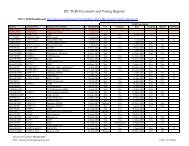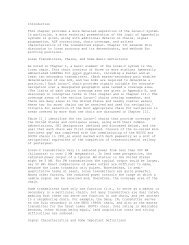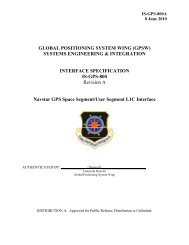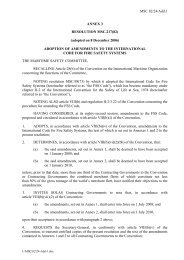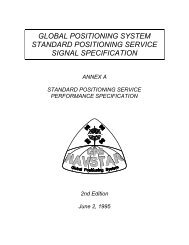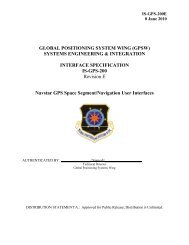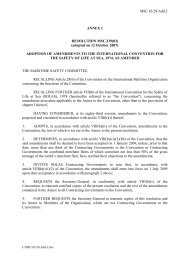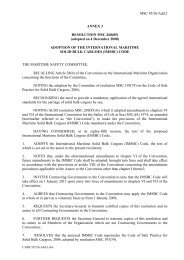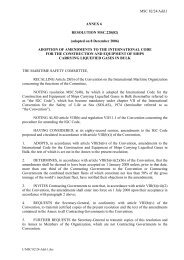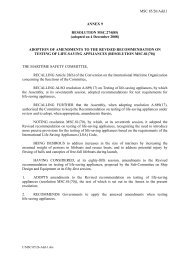MSC 75/24/Add.1 ANNEX 2 RESOLUTION MSC.123(75) (adopted ...
MSC 75/24/Add.1 ANNEX 2 RESOLUTION MSC.123(75) (adopted ...
MSC 75/24/Add.1 ANNEX 2 RESOLUTION MSC.123(75) (adopted ...
- No tags were found...
Create successful ePaper yourself
Turn your PDF publications into a flip-book with our unique Google optimized e-Paper software.
<strong>MSC</strong> <strong>75</strong>/<strong>24</strong>/<strong>Add.1</strong><strong>ANNEX</strong> 2<strong>RESOLUTION</strong> <strong>MSC</strong>.123(<strong>75</strong>)(<strong>adopted</strong> on <strong>24</strong> May 2002)ADOPTION OF AMENDMENTS TO THE INTERNATIONAL CONVENTIONFOR THE SAFETY OF LIFE AT SEA, 1974, AS AMENDEDTHE MARITIME SAFETY COMMITTEE,RECALLING Article 28(b) of the Convention on the International Maritime Organizationconcerning the functions of the Committee,RECALLING FURTHER article VIII(b) of the International Convention for the Safety ofLife at Sea (SOLAS), 1974 (hereinafter referred to as "the Convention"), concerning theamendment procedure applicable to the Annex to the Convention, other than to the provisions ofchapter I thereof,HAVING CONSIDERED, at its seventy-fifth session, amendments to the Convention,proposed and circulated in accordance with article VIII(b)(i) thereof,1. ADOPTS, in accordance with article VIII(b)(iv) of the Convention, amendments to theConvention, the text of which is set out in the Annex to the present resolution;2. DETERMINES, in accordance with article VIII(b)(vi)(2)(bb) of the Convention, that thesaid amendments shall be deemed to have been accepted on 1 July 2003, unless, prior to thatdate, more than one third of the Contracting Governments to the Convention or ContractingGovernments the combined merchant fleets of which constitute not less than 50% of the grosstonnage of the world’s merchant fleet, have notified their objections to the amendments;3. INVITES SOLAS Contracting Governments to note that, in accordance witharticle VIII(b)(vii)(2) of the Convention, the amendments shall enter into force on 1 January2004 upon their acceptance in accordance with paragraph 2 above;4. REQUESTS the Secretary-General, in conformity with article VIII(b)(v) of theConvention, to transmit certified copies of the present resolution and the text of the amendmentscontained in the Annex to all Contracting Governments to the Convention;5. FURTHER REQUESTS the Secretary-General to transmit copies of this resolution andits Annex to Members of the Organization, which are not Contracting Governments to theConvention.I:\<strong>MSC</strong>\<strong>75</strong>\<strong>24</strong>-ADD.1.DOC
<strong>MSC</strong> <strong>75</strong>/<strong>24</strong>/<strong>Add.1</strong><strong>ANNEX</strong> 2Page 2<strong>ANNEX</strong>AMENDMENTS TO THE INTERNATIONAL CONVENTION FOR THE SAFETY OFLIFE AT SEA, 1974, AS AMENDEDRegulation 1 - Application1 Paragraphs 3, 4, 5, 6 and 7 are deleted.CHAPTER IVRADIOCOMMUNICATIONS2 Existing paragraph 8 is renumbered as paragraph 3.Regulation 3 - Exemptions3 The word "; or" at the end of paragraph 2.1 is replaced by full stop(.).4 Paragraph 2.3 is deleted.Regulation 4 - Functional requirements5 In paragraph 1.6, the reference to “V/12(g) and (h)” is replaced by “V/19.2.3.2”.Regulation 7 - Radio equipment: General6 Paragraphs 2, 3 and 4 are deleted.7 Existing paragraph 5 is renumbered as paragraph 2.Regulation 12 - Watches8 Paragraph 4 is deleted.Regulation 14 - Performance standards9 In paragraph 1, in the second sentence, the words “Subject to paragraph 2” are deleted.10 Paragraph 2 is deleted.I:\<strong>MSC</strong>\<strong>75</strong>\<strong>24</strong>-ADD.1.DOC
<strong>MSC</strong> <strong>75</strong>/<strong>24</strong>/<strong>Add.1</strong><strong>ANNEX</strong> 2Page 3Regulation 21 – International Code of SignalsCHAPTER VSAFETY OF NAVIGATION11 The title of the regulation is replaced by the following:“International Code of Signals and IAMSAR Manual”12 The existing paragraph is numbered as paragraph 1.13 A new paragraph 2 is added as follows:“2 All ships shall carry an up-to-date copy of Volume III of the InternationalAeronautical and Maritime Search and Rescue (IAMSAR) Manual.”Regulation 2 - Cargo informationCHAPTER VICARRIAGE OF CARGOES14 In existing paragraph 2.3, the words “regulation VII/2” are replaced by the words“the IMDG Code, as defined in regulation VII/1.1”.Regulation 5 – Stowage and securing15 In existing paragraph 1, the words “Cargo and cargo units” are replaced by the words“Cargo, cargo units * and cargo transport units ** ”.16 In existing paragraph 2, the words “cargo carried in cargo unit” are replaced by the words“cargo, cargo units and cargo transport units”.17 In existing paragraph 4, the words “cargo units” are replaced by the words “cargo unitsand cargo transport units” (in two places).18 In existing paragraph 5, the word "Containers" is replaced by the words "Freightcontainers" and in the last line, after "(CSC)", at the end of the sentence, the words ",as amended"are added.19 Existing paragraph 6 is replaced by the following:"All cargoes, other than solid and liquid bulk cargoes, cargo units and cargo transportunits shall be loaded, stowed and secured throughout the voyage in accordance with theCargo Securing Manual approved by the Administration. In ships with ro-ro spaces, asdefined in regulation II-2/3.41, all securing of such cargoes, cargo units and cargo***Refer to the Code of Safe Practice for Cargo Stowage and Securing, <strong>adopted</strong> by the Organization byresolution A.714(17), as amended.Refer to the International Maritime Dangerous Goods (IMDG) Code, <strong>adopted</strong> by the Organization byresolution <strong>MSC</strong>.122(<strong>75</strong>).I:\<strong>MSC</strong>\<strong>75</strong>\<strong>24</strong>-ADD.1.DOC
<strong>MSC</strong> <strong>75</strong>/<strong>24</strong>/<strong>Add.1</strong><strong>ANNEX</strong> 2Page 4transport units, in accordance with the Cargo Securing Manual, shall be completed beforethe ship leaves the berth. The Cargo Securing Manual shall be drawn up to a standard atleast equivalent to relevant guidelines developed by the Organization * ."Regulation 6 – Acceptability for shipment20 In existing paragraph 3, the words “regulation VII/2” are replaced by the words“the IMDG Code, as defined in regulation VII/1.1”.CHAPTER VIICARRIAGE OF DANGEROUS GOODS21 Existing part A is replaced by the following new part A and part A-1:“PART ACARRIAGE OF DANGEROUS GOODS IN PACKAGED FORMRegulation 1DefinitionsFor the purpose of this chapter, unless expressly provided otherwise:1 IMDG Code means the International Maritime Dangerous Goods (IMDG) Code<strong>adopted</strong> by the Maritime Safety Committee of the Organization by resolution<strong>MSC</strong>.122(<strong>75</strong>), as may be amended by the Organization, provided that such amendmentsare <strong>adopted</strong>, brought into force and take effect in accordance with the provisions ofarticle VIII of the present Convention concerning the amendment procedures applicableto the Annex other than chapter I.2 Dangerous goods mean the substances, materials and articles covered by theIMDG Code.3 Packaged form means the form of containment specified in the IMDG Code.Regulation 2Application **1 Unless expressly provided otherwise, this part applies to the carriage of dangerousgoods in packaged form in all ships to which the present regulations apply and in cargoships of less than 500 gross tonnage.***Refer to the Guidelines on the preparation of the cargo securing manual (<strong>MSC</strong>/Circ.745).Refer to:.1 part D which contains special requirements for the carriage of INF cargo; and.2 regulation II-2/19 which contains special requirements for ships carrying dangerous goods.I:\<strong>MSC</strong>\<strong>75</strong>\<strong>24</strong>-ADD.1.DOC
2 The provisions of this part do not apply to ships' stores and equipment.<strong>MSC</strong> <strong>75</strong>/<strong>24</strong>/<strong>Add.1</strong><strong>ANNEX</strong> 2Page 53 The carriage of dangerous goods in packaged form is prohibited except inaccordance with the provisions of this chapter.4 To supplement the provisions of this part, each Contracting Government shallissue, or cause to be issued, detailed instructions on emergency response and medical firstaid relevant to incidents involving dangerous goods in packaged form, taking into accountthe guidelines developed by the Organization. *Regulation 3Requirements for the carriage of dangerous goodsThe carriage of dangerous goods in packaged form shall be in compliance with therelevant provisions of the IMDG Code.Regulation 4Documents1 In all documents relating to the carriage of dangerous goods in packaged form by sea,the proper shipping name of the goods shall be used (trade names alone shall not be used) andthe correct description given in accordance with the classification set out in the IMDG Code.2 The transport documents prepared by the shipper shall include, or be accompanied by, asigned certificate or a declaration that the consignment, as offered for carriage, is properlypackaged, marked, labelled or placarded, as appropriate, and in proper condition for carriage.3 The person(s) responsible for the packing/loading of dangerous goods in a cargotransport unit ** shall provide a signed container/vehicle packing certificate stating that thecargo in the unit has been properly packed and secured and that all applicable transportrequirements have been met. Such a certificate may be combined with the document referredto in paragraph 2.4 Where there is due cause to suspect that a cargo transport unit in whichdangerous goods are packed is not in compliance with the requirements of paragraph 2or 3, or where a container/vehicle packing certificate is not available, the cargo transportunit shall not be accepted for carriage.5 Each ship carrying dangerous goods in packaged form shall have a special list ormanifest setting forth, in accordance with the classification set out in the IMDG Code, thedangerous goods on board and the location thereof. A detailed stowage plan, which***Refer to:.1 the Emergency Response Procedures for Ships Carrying Dangerous Goods (EmS Guide)(<strong>MSC</strong>/Circ.1025); and.2 the Medical First Aid and the Medical First Aid Guide for Use in Accidents Involving DangerousGoods (MFAG) (<strong>MSC</strong>/Circ.857);published by the Organization.Refer to the International Maritime Dangerous Goods (IMDG) Code, <strong>adopted</strong> by the Organization byresolution <strong>MSC</strong>.122(<strong>75</strong>).I:\<strong>MSC</strong>\<strong>75</strong>\<strong>24</strong>-ADD.1.DOC
<strong>MSC</strong> <strong>75</strong>/<strong>24</strong>/<strong>Add.1</strong><strong>ANNEX</strong> 2Page 6identifies by class and sets out the location of all dangerous goods on board, may be usedin place of such a special list or manifest. A copy of one of these documents shall bemade available before departure to the person or organization designated by the port Stateauthority.Regulation 5Cargo Securing ManualCargo, cargo units * and cargo transport units, shall be loaded, stowed and securedthroughout the voyage in accordance with the Cargo Securing Manual approved by theAdministration. The Cargo Securing Manual shall be drawn up to a standard at leastequivalent to the guidelines developed by the Organization. **Regulation 6Reporting of incidents involving dangerous goods1 When an incident takes place involving the loss or likely loss overboard ofdangerous goods in packaged form into the sea, the master, or other person having chargeof the ship, shall report the particulars of such an incident without delay and to the fullestextent possible to the nearest coastal State. The report shall be drawn up based on generalprinciples and guidelines developed by the Organization. ***2 In the event of the ship referred to in paragraph 1 being abandoned, or in the eventof a report from such a ship being incomplete or unobtainable, the company, as defined inregulation IX/1.2, shall, to the fullest extent possible, assume the obligations placed uponthe master by this regulation.PART A-1CARRIAGE OF DANGEROUS GOODS IN SOLID FORM IN BULKRegulation 7DefinitionsDangerous goods in solid form in bulk means any material, other than liquid or gas,consisting of a combination of particles, granules or any larger pieces of material,generally uniform in composition, which is covered by the IMDG Code and is loadeddirectly into the cargo spaces of a ship without any intermediate form of containment, andincludes such materials loaded in a barge on a barge-carrying ship.******As defined in the Code of Safe Practice for Cargo Stowage and Securing, <strong>adopted</strong> by the Organization byresolution A.715(17), as amended.Refer to the Guidelines for the preparation of the cargo securing manual (<strong>MSC</strong>/Circ.745).Refer to the General principles for ship reporting systems and ship reporting requirements, includingGuidelines for reporting incidents involving dangerous goods, harmful substances and/or marine pollutants,<strong>adopted</strong> by the Organization by resolution A.851(20).I:\<strong>MSC</strong>\<strong>75</strong>\<strong>24</strong>-ADD.1.DOC
<strong>MSC</strong> <strong>75</strong>/<strong>24</strong>/<strong>Add.1</strong><strong>ANNEX</strong> 2Page 7Regulation 7-1Application *1 Unless expressly provided otherwise, this part applies to the carriage of dangerousgoods in solid form in bulk in all ships, to which the present regulations apply and incargo ships of less than 500 gross tonnage.2 The carriage of dangerous goods in solid form in bulk is prohibited except inaccordance with the provisions of this part.3 To supplement the provisions of this part, each Contracting Government shallissue, or cause to be issued, detailed instructions on the safe carriage of dangerous goodsin solid form in bulk ** which shall include instructions on emergency response andmedical first aid relevant to incidents involving dangerous goods in solid form in bulk,taking into account the guidelines developed by the Organization. ***Regulation 7-2Documents1 In all documents relating to the carriage of dangerous goods in solid form in bulkby sea, the bulk cargo shipping name of the goods shall be used (trade names alone shallnot be used).2 Each ship carrying dangerous goods in solid form in bulk shall have a special listor manifest setting forth the dangerous goods on board and the location thereof. Adetailed stowage plan, which identifies by class and sets out the location of all dangerousgoods on board, may be used in place of such a special list or manifest. A copy of one ofthese documents shall be made available before departure to the person or organizationdesignated by the port State authority.Regulation 7-3Stowage and segregation requirements1 Dangerous goods in solid form in bulk shall be loaded and stowed safely andappropriately in accordance with the nature of the goods. Incompatible goods shall besegregated from one another.******Refer to regulation II-2/19, which contains special requirements for ships carrying dangerous goods.Refer to the Code of Safe Practice for Solid Bulk Cargoes (BC Code), <strong>adopted</strong> by the Organization byresolution A.434(XI), as amended.Refer to the Medical First Aid Guide for Use in Accidents involving Dangerous Goods (MFAG)(<strong>MSC</strong>/Circ.857).I:\<strong>MSC</strong>\<strong>75</strong>\<strong>24</strong>-ADD.1.DOC
<strong>MSC</strong> <strong>75</strong>/<strong>24</strong>/<strong>Add.1</strong><strong>ANNEX</strong> 2Page 82 Dangerous goods in solid form in bulk which are liable to spontaneous heating orcombustion shall not be carried unless adequate precautions have been taken to minimizethe likelihood of the outbreak of fire.3 Dangerous goods in solid form in bulk which give off dangerous vapours shall bestowed in a well ventilated cargo space.Regulation 7-4Reporting of incidents involving dangerous goods1 When an incident takes place involving the loss or likely loss overboard ofdangerous goods in solid form in bulk into the sea, the master, or other person havingcharge of the ship, shall report the particulars of such an incident without delay and to thefullest extent possible to the nearest coastal State. The report shall be drawn up based ongeneral principles and guidelines developed by the Organization. *2 In the event of the ship referred to in paragraph 1 being abandoned, or in the eventof a report from such a ship being incomplete or unobtainable, the company, as defined inregulation IX/1.2, shall, to the fullest extent possible, assume the obligations placed uponthe master by this regulation.”PART DSPECIAL REQUIREMENTS FOR THE CARRIAGE OF PACKAGEDIRRADIATED NUCLEAR FUEL, PLUTONIUM AND HIGH-LEVELRADIOACTIVE WASTES ON BOARD SHIPSRegulation 14 - Definitions22 Existing paragraph 2 is replaced by the following:"2 INF cargo means packaged irradiated nuclear fuel, plutonium and high-levelradioactive wastes carried as cargo in accordance with class 7 of the IMDG Code."23 Existing paragraph 6 is deleted.*Refer to the General Principles for Ship Reporting Systems and Ship Reporting Requirements, includingguidelines for reporting incidents involving dangerous goods, harmful substances and/or marine pollutants<strong>adopted</strong> by the Organization by resolution A.851(20).I:\<strong>MSC</strong>\<strong>75</strong>\<strong>24</strong>-ADD.1.DOC
<strong>MSC</strong> <strong>75</strong>/<strong>24</strong>/<strong>Add.1</strong><strong>ANNEX</strong> 2Page 9APPENDIXCERTIFICATESRecord of Equipment for the Passenger Ship Safety Certificate (Form P)<strong>24</strong> In section 3, items 7 and 8 and related footnotes are deleted.Record of Equipment for the Cargo Ship Safety Radio Certificate (Form R)25 In section 2, items 7 and 8 and related footnotes are deleted.26 Section 4 is deleted.***I:\<strong>MSC</strong>\<strong>75</strong>\<strong>24</strong>-ADD.1.DOC




